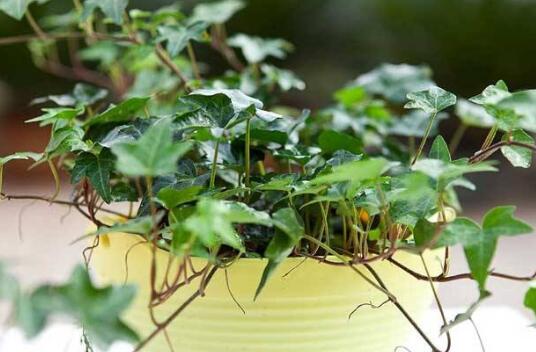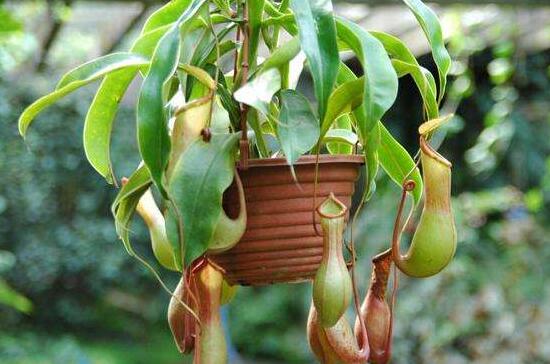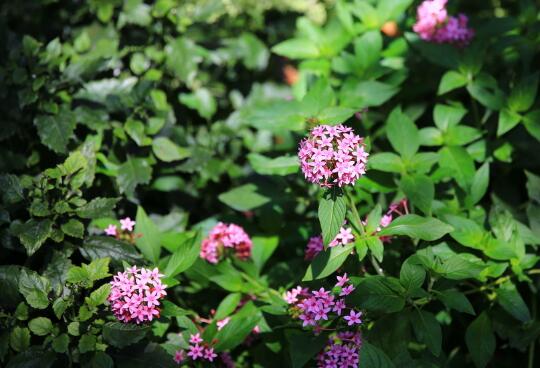How to propagate ivy, the propagation method of ivy / the steps of ivy cuttage
Ivy is known as the best formaldehyde-absorbing plant, so more and more people grow it, so it is time to consider the problem of reproduction, so how to reproduce is better? Many flower lovers don't know about this, so here are two common ways to propagate ivy.
How does ivy reproduce?

The stem vine of ivy is relatively easy to take root, so it is not difficult to reproduce. Botanists use three methods, namely, cutting, striping and sowing. Because ivy is difficult to seed in the north, sowing methods are less used. the two methods commonly used are crimping and cutting.
Propagation methods of Ivy
1. Striping propagation
How do you reproduce ivy by striping? Choose a robust 3-4-year-old plant, bury the stem vine in the soil, then use a brick to press the stem vine on the soil surface, pay attention to keep the spit surface moist, after a period of time, its node will grow new roots, cut into a section according to every 3-5 nodes, 30 days later, the leaf axilla will grow out of the stem vine, and then transplant into the pot.
Second, the cutting method of Ivy
1. Ivy cutting time
Indoor planting ivy, cutting time is generally chosen in spring or autumn, such as April-May, August-September is more appropriate; greenhouse cultivation of ivy, there is no time limit, year-round cutting, and the use of cutting often ivy how to propagate? The steps are as follows.
2. Cutting steps
The selection of ⑴ matrix. The selection of sandy acid soil, the soil should be as loose as possible, aeration and drainage is good, the importance of the substrate we have in the ivy culture methods and matters needing attention in detail, we will not elaborate here.
⑵ selects branches. Choose semi-lignified strong branches, too young or old branches are not suitable, in addition, diseased branches and dead branches can not be selected. It is generally suitable for the sturdy branches at the top of the ivy.
⑶ makes cuttings. Cut the selected branches into 10-20 cm each segment, make sure that each segment contains at least 3-4 nodes, and have aerial roots at the base, cut off the leaves at the base, and retain the top 3-5 leaves.
⑷ cuttage. Insert the prepared cuttings into the substrate and press the soil around the cuttings slightly to make sure the cuttings are upright.
⑸ watering. After the cuttage is finished, the cuttings should be watered in time, and the watering must be thoroughly watered to ensure that the upper and lower parts of the substrate are hydrated, and then put the pot in one or two places for maintenance.
⑹ post-management. Control the temperature and light, generally about 15 days can take root, at this time can not transplant, but let it grow on the substrate for a period of time, generally in 40 days or so the root system will be well developed, and then transplant.
⑺ transplant. After transplanting ivy, do not put it directly in the sun, it takes about 3 days to slow down the seedling, the leaves may droop or turn yellow when the seedling is slow, and it needs to be watered in time, and after the slow seedling stage, it can be managed normally according to the breeding method of ivy.
How does ivy reproduce? Propagation methods of Ivy
[FAQ] how does ivy reproduce? Propagation methods of Ivy
Picture: Ivy
[expert answers]
Ivy can be propagated by sowing, cutting and striping. Generally, sowing can be carried out in the south of the Yangtze River and South China, but it is difficult to seed in the north.
1. Seed propagation
Ivy seed reproduction, as long as it refers to fruit ripe harvest, stacking after ripening, soaking and kneading, ghost seeds washed and dry, can be sowed, can also block wet sand storage, the following spring sowing, sowing after sowing soil 1cm, cover grass moisturizing. The seedlings were unearthed and shaded in a shed, and large seedlings were cultivated after transplanting or fixing seedlings in the spring of the second year.
2. Cuttage propagation
The method of ivy cuttage propagation is to use twigs with air roots to survive most easily in the growing season, close with plastic film arch shed after planting, and shade, keep the space temperature 80% Mel 90%, but the bed soil should not be too wet, lest the cuttings rot, it will take about 30 days to take root.
The key to the survival of ivy cuttings is the selection of cuttings and the season of cutting, generally choose semi-lignified robust branches, too tender, too old are not easy to cut. Each section is 3-4 sections, 10-20 cm long, and the basal 1-2 segments with aerial roots are inserted into the culture soil. The suitable time for cutting is March-May or August-September. The substrate of cutting is medium sand after disinfection, temperature control is 20-26 ℃, humidity is 80%-90%, cover with plastic film, soak with 1000 mg / L rooting powder for 30 seconds before insertion. It can take root 20-30 days after insertion, and the environment of high air humidity and scattered light should be maintained in management.
3. Striping propagation
The practice of ivy striping propagation is carried out in spring and autumn, using wavy striping method, after the buried part is cut around, it is very easy to take root, which is a relatively simple propagation method.
Ivy is a more popular indoor foliage plant, which can not only decorate the home, but also benefit the purification and improvement of the household air. I hope that through the introduction of the editor, you can know how to breed ivy.
[editor's summary]
Ivy is a common foliage plant in daily life, which is mostly used for vertical planting in the courtyard. There are three propagation methods of ivy, which are seed propagation, cutting propagation and striping propagation, but the most common and commonly used methods are cutting propagation and striping propagation. In this article, the editor of the first Agricultural Classic will introduce you in detail the specific operation of these three breeding methods. I hope it will be helpful to you.
How do you cut ivy? Cutting methods of Ivy
Ivy is a common indoor potted plant with beautiful plant type and green leaves, which has high ornamental value. The stem of ivy is easy to take root, so cuttage is usually used in the process of propagation, and it is suitable for family cutting from April to May in spring and August to September in autumn. So, how do you cut ivy? Now the cutting methods of ivy are introduced as follows.
Picture: Ivy
I. preparation of inserts
Take branches about 30 centimeters long from the top of ivy and carefully check whether there are insect tracks on the leaves and stems before planting. In particular, plants brought back from the wild should not bring back pests. Cutting branches will not affect the growth of the mother plant. It can even promote the mother plant to branch and grow more new branches. Cut the ivy into segments about eight or nine centimeters long, be careful to use scissors, not with your hands, otherwise it will damage the plant tissue at the fracture and cut off the leaves at the bottom, leaving only the 2-4 leaves at the top.
Picture: Ivy
Second, cutting substrate
Prepare several disposable plastic cups and cut three or four holes in the bottom instead of flowerpots. This kind of "flowerpot" has several advantages. First, the soil is less, dry and wet alternately fast, and the cuttings will not rot because the soil is too wet for a long time. Second, the transparent cup can clearly observe the situation of plant rooting, root development and re-transplantation is conducive to survival. Third, it is convenient to transplant, when transplanting, buckle the cup backwards and protrude the complete clod, which can ensure that the root of the seedling will not be hurt. Fourth, it covers a small area. After cutting the hole at the bottom of the cup, put in the breathable soil, or sand, poke a hole in the soil in the middle of the cup with your fingers or chopsticks, put at least one branch that has cut off the leaves in the soil, and then fill the soil and press the soil around the cuttings slightly so that it will not stagger when watering.
Picture: Ivy
III. Cutting management
1. Watering management: after the ivy is watered thoroughly, it can be placed in a bright place without direct sunlight. In the first few days, you can water it every two days or so. After about a week, you can gradually reduce the frequency of watering, wait until the soil is slightly dry, and then water it again. Be careful not to let the soil completely dry.
two。 Rooting and transplanting: cutting ivy can take root in about 15-20 days under proper management and temperature. Do not rush to transplant after rooting, let the seedlings continue to grow in the cup for a period of time, after a month and a half, the root system has developed well, you can transplant to a larger flowerpot.
3. Maintenance after planting: after the ivy seedlings are transplanted, pour water thoroughly, first slow the seedlings in a place where there is no direct sunlight for two or three days, and then you can see the sun. Shape can be according to personal preferences, like a large fluffy basin, put in plenty of sunshine, watering can be mixed with urea or nitrogen fertilizer in the water, and often take off the top to promote it to be more branched. Like the elegant curl of Tingting, it is placed in a place where the indoor light is bright but there is no direct sunlight, and there is no need to put on fat, allowing it to grow freely.
[conclusion] Cuttage propagation is the most important propagation method of ivy, and many pots can be raised by pinching a branch. The above introduced the cutting method of ivy, have you all learned it?
- Prev

How to propagate pitcher plants, three propagation methods / cuttings / striping / sowing
For pitcher plant, we should have heard that it is a mosquito repellent plant, potted by many people at home. With more and more people raising pitcher plants, it is also multiplied in large numbers, so how do pitcher plants reproduce? Buy plants or reproduce on your own, and there are three main propagation methods of pitcher plants: cutting, striping and sowing.
- Next

How to propagate orchids? propagation methods / cutting propagation / striping propagation of orchids
Orchid is a kind of highly ornamental flower plant, which can be seen in many areas of our country, and many people choose to raise it at home. With more people raising it, people are more concerned about the reproduction of orchids. How do orchids reproduce? What are the propagation methods of orchids?
Related
- Fuxing push coffee new agricultural production and marketing class: lack of small-scale processing plants
- Jujube rice field leisure farm deep ploughing Yilan for five years to create a space for organic food and play
- Nongyu Farm-A trial of organic papaya for brave women with advanced technology
- Four points for attention in the prevention and control of diseases and insect pests of edible fungi
- How to add nutrient solution to Edible Fungi
- Is there any good way to control edible fungus mites?
- Open Inoculation Technology of Edible Fungi
- Is there any clever way to use fertilizer for edible fungus in winter?
- What agents are used to kill the pathogens of edible fungi in the mushroom shed?
- Rapid drying of Edible Fungi

